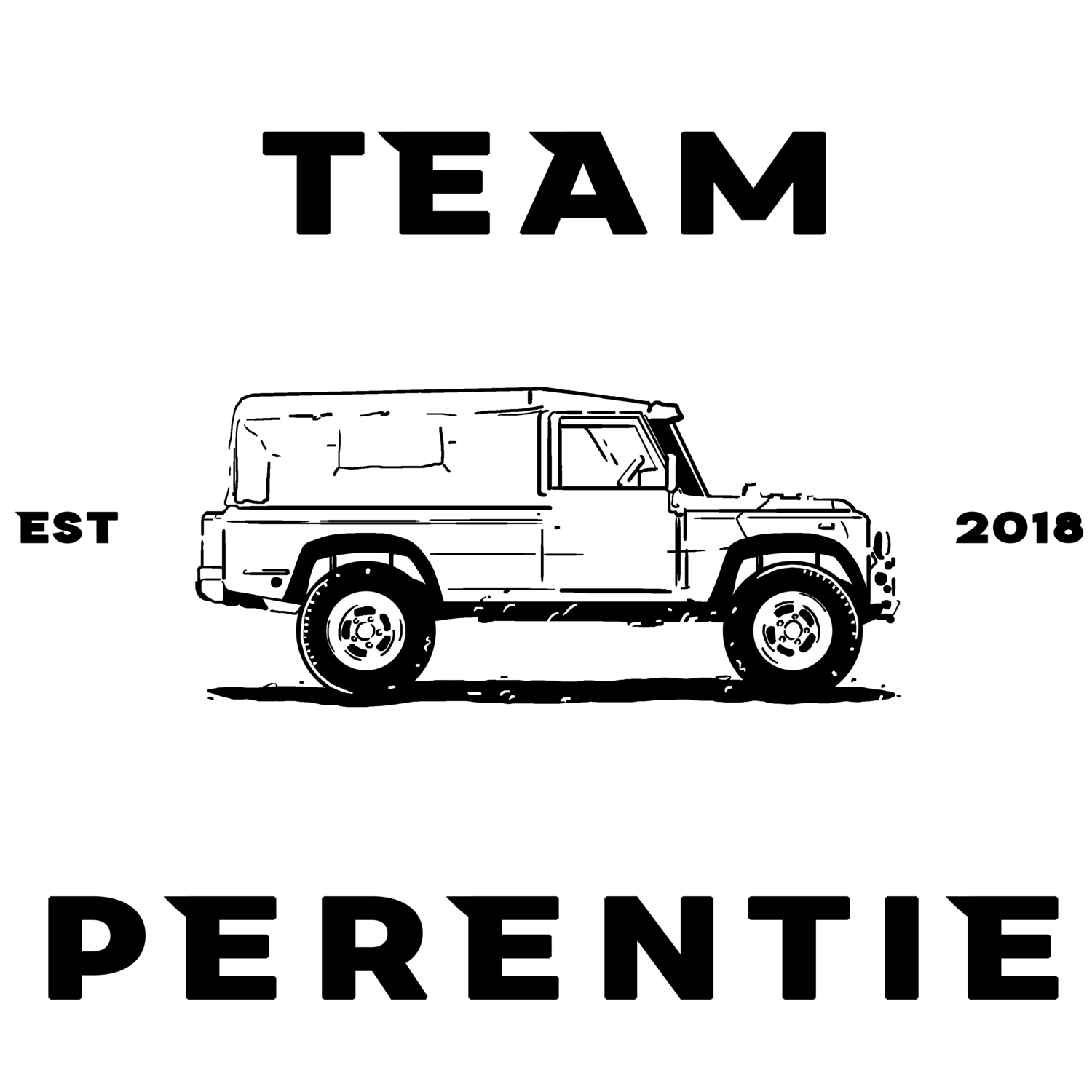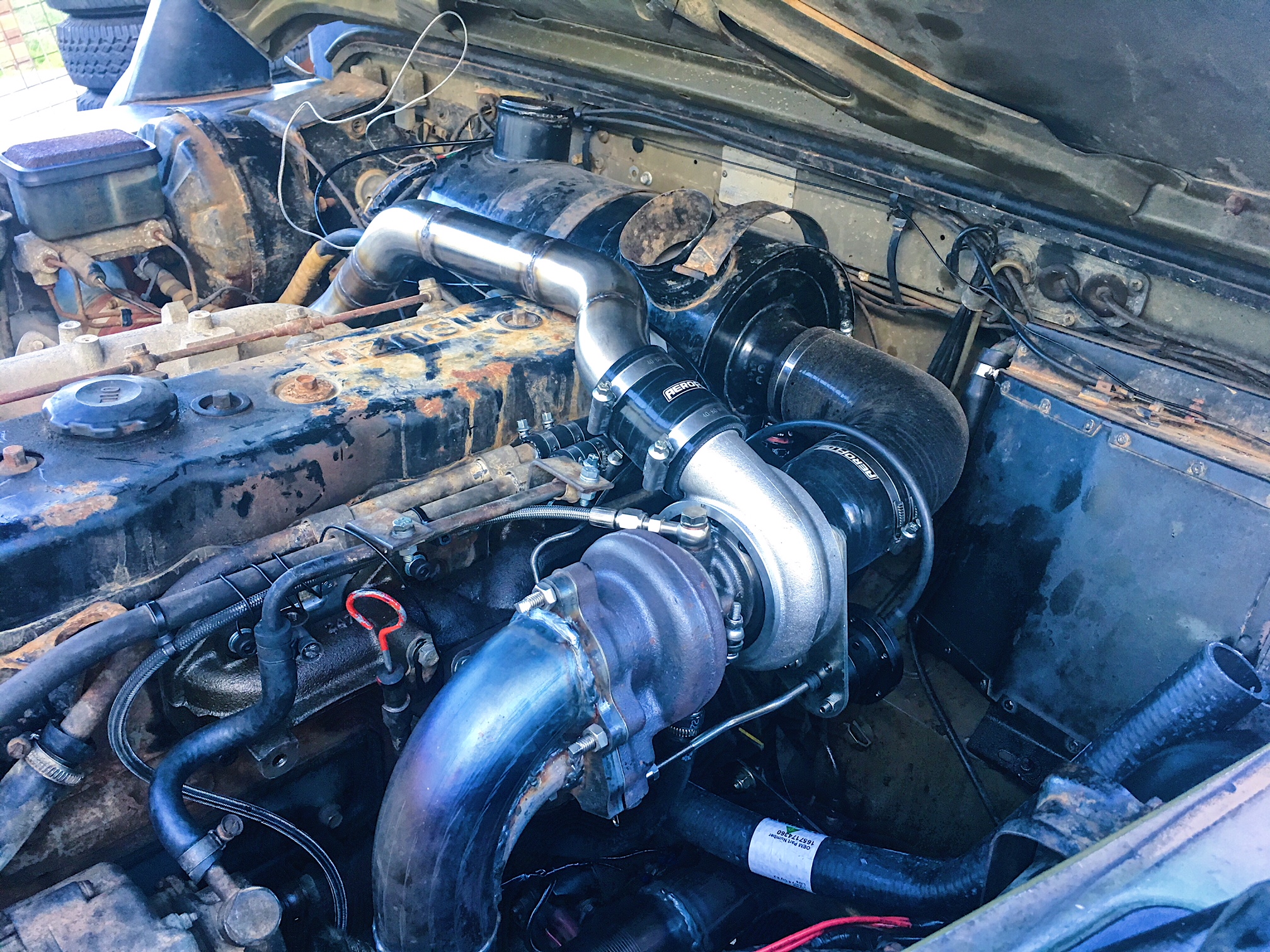Should I Turbo my Perentie?
If you’ve come here to try and decide whether or not to boost up your lizard, my advice is a resounding HELL YES. Adding even mild boost to the 4bd1 makes the Perentie an entirely different vehicle. She will get off the line, keep up with traffic, cruise at highway speeds and make spool and chirp noises that spur you to stick the boot in. Everything feels smoother, like she isn’t working as hard.
The assortment of turbo bits I picked up on gumtree sat in my garage for 6 months before I had the luxury of taking my truck off the road to install it all. I’ve been frothing on ‘P-TEW!’ noises for a year now and my only regret is that I lived without boost for four years prior. The DIY install took longer, was more difficult and ultimately more expensive than I anticipated, but I am at best an enthusiastic novice on the spanners.
TURBO 101
A turbo uses the exhaust gas being expelled from your manifold to pressurize air that is then pumped back into the engine under pressure (boost). An increased quantity of fuel and air combusted in a given sized cylinder gives an increase in power. Diesel engines are particularly suited to the use of turbo chargers. Naturally aspirated diesels have a poor power to weight ratio, as they are built to handle the much higher compression required to burn diesel. A turbo is a light weight addition that improves power, torque and efficiency.
ISUZU 4BD1
Factory numbers, taken at the crank. The Stock N/A unit produces:
78KW @ 3200 RPM
263 NM of torque @ 1900 RPM
Factory numbers using a Garrett T25 turbo, and peak boost of 13psi delivers:
105KW @ 3000 RPM
330 NM of torque @ 1800 RPM
So you can see that not only do you produce more power and torque, it is available to you lower in the rev range. This helps you get off the line and makes the Perentie much more pleasant to live with as a daily driver. Followers who have put their vehicles on the dyno have reported power increases of over to 100%, upping horsepower from 60 to as much 140 at the wheels. EPIC.
What are my options?
By far the most common solution is to drop your truck at KLR and have them fit the whole thing for you. A survey on the Land Rover Perentie owners forum showed 42 of the 75 turbo setups were from KLR and all reports are that it works great, producing heaps of low end torque. The turbo used is a Garrett GT2252, bolted to a custom made manifold and a really neat custom crossover pipe. There is no intercooler and the stock air filter is retained. The system runs around 13psi boost and max EGT’s of around 550.
The price installed may be updated, but it is around $5500, not including a custom exhaust (mine cost $900) or a heavy duty clutch ($2500 installed), both of which are highly recommended. You can check out the KLR website here.
KLR setup. Note the tubular manifold, very neat crossover pipe and retention of the standard air box. Oil breather is attached to the heater box.
My Setup
I purchased the bulk of my turbo bits from a bloke who was under orders from the Mrs to get rid of his Perentie. Very foolish my friend! For $1000 I bought:
Kinugawa Turbocharger TD04HL-19T (currently on ebay for $909)
Turbo adaptor T25 to T3 ($220 from GCG turbos)
Factory Isuzu turbo manifold (available new from SMS diesel spares $271)
Feed line, Return line and gaskets including a T3 turbo exhaust gasket
From there it was a matter of fitting it all in. Some issues I faced were: drilling the turbo itself to change the outlet angle to face over the top of the engine (ideally a turbo needs a straight section of pipe at the outlet before any bends), custom making the crossover pipe and shaving some of the bonnet structure so it didn’t rub, re-positioning the oil breather, reversing and modifying the air filter. I finished it off with a 3” straight through exhaust and fully sick side exit.
Side pipe action
I run peak boost of 13psi and at Highway speeds under heavy load my EGT maxes out at around 550-600. From reports this seems almost identical to the KLR setup. Using this setup I was able set and currently hold the world record for a Perentie down the quarter mile of 19.812 seconds. RAPID!
Note the temporary removal of the oil breather which was repositioned to the heater box. Apologies for the state of the engine bay and the obvious oversight - not repainting the rocker cover :)
Optimising your Turbo’s performance
Air Filter
Adding a turbo to your Perentie increases the required airflow. Remember we are trying to stuff as much 02 into the engine as possible, along with more fuel, to make a bigger bang!
Airflow requirements increase through the rev range. With a N/A (Naturally aspirated) 4BD1, airflow is as follows, expressed in cfm (cubic feet per minute)
600 RPM = 34cfm
1800 RPM = 104cfm
3300 RPM = 202cfm
Adding a turbo (Garrett GT25 @ 13psi) increases the airflow to:
600 RPM = 57
1800 RPM = 171
3300 RPM = 333
The thing is, the Stock Donaldson unit is rated to only 230cfm. We can see that this is fine for the N/A engine, never drawing more than 202cfm. When we add a turbo, as we rev past around 2000 RPM we are not able to deliver the air the engine needs for optimal pressure. When we run higher boost, we may run into this problem even lower in the rev range. The result is excellent torque low in the rev range, but issues with higher EGTs and power loss in the upper rev range.
The solution is to change to an air filtration system with higher rated airflow, for example the Donaldson power core PSD (pictured), rated to 974 cfm. I am investigating this for my setup, please let me know if you find a good option that fits under the bonnet! I think this mad max style thing looks pretty sick, but ideally I’d prefer everything to fit under a stock or even a puma bonnet.
KLR turbo setup, with the addition of a powercore PSD air filter, not fully installed at this stage.
Intercooler
Another way of jamming more 02 into your engine is by cooling it down. Cold air is more dense than hot air, hence the use of an intercooler. An added advantage is that if your turbo shreds itself, there is a barrier between it and your engine’s internals.
An air to air intercooler is simply an additional radiator, normally mounted in front of the vehicle’s existing radiator. Air is cooled by heat exchange with the ambient air.
A Holset super HX30 turbo fed into an air to air intercooler. Runs 30+ psi. Stock air filter retained.
A water to air intercooler consists of three main components: intercooler, radiator and pump. Hot air from the turbo flows through the intercooler and is cooled by water which has been pumped through its own separate radiator. The advantages of this system are that there is no pressure loss from the turbo like in an air to air system, and inlet air can be cooled to lower than ambient temperature. The downside is increased cost and complexity, but in time I hope to add this type of system to my truck.
Water to air intercooler and Powercore air filter, all neatly contained under a puma bonnet. The goal. Also looks like a 4” dump pipe. Froth.
A note on EGT’s
The goal is to produce as much as power as possible while keeping Exhaust gas temperature (pre turbo) within a safe range. Sustained EGTs above 700 degrees can do serious damage to your engine.
Other’s setups. Many thanks to Team P followers:
HX30w turbo at 30psi, runs 450 EGT at 100km/h, without intercooler
TD04HL-19T turbo at 28psi, runs 650 EGT max with a water to air intercooler
TD04HL-19T turbo at 28psi, intercooled, 350 EGT cruise, up to 700 max
Thanks to everyone that contributed to this article, which is an ongoing project. I plan to add more info as I continue to develop my own setup. Special thanks to @sprocketdiver, check out his insta account.








